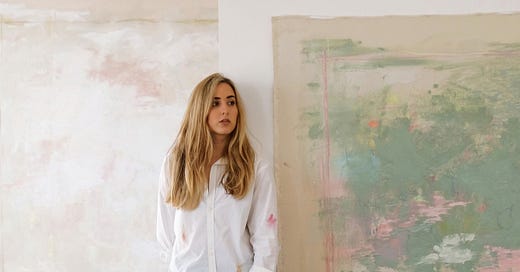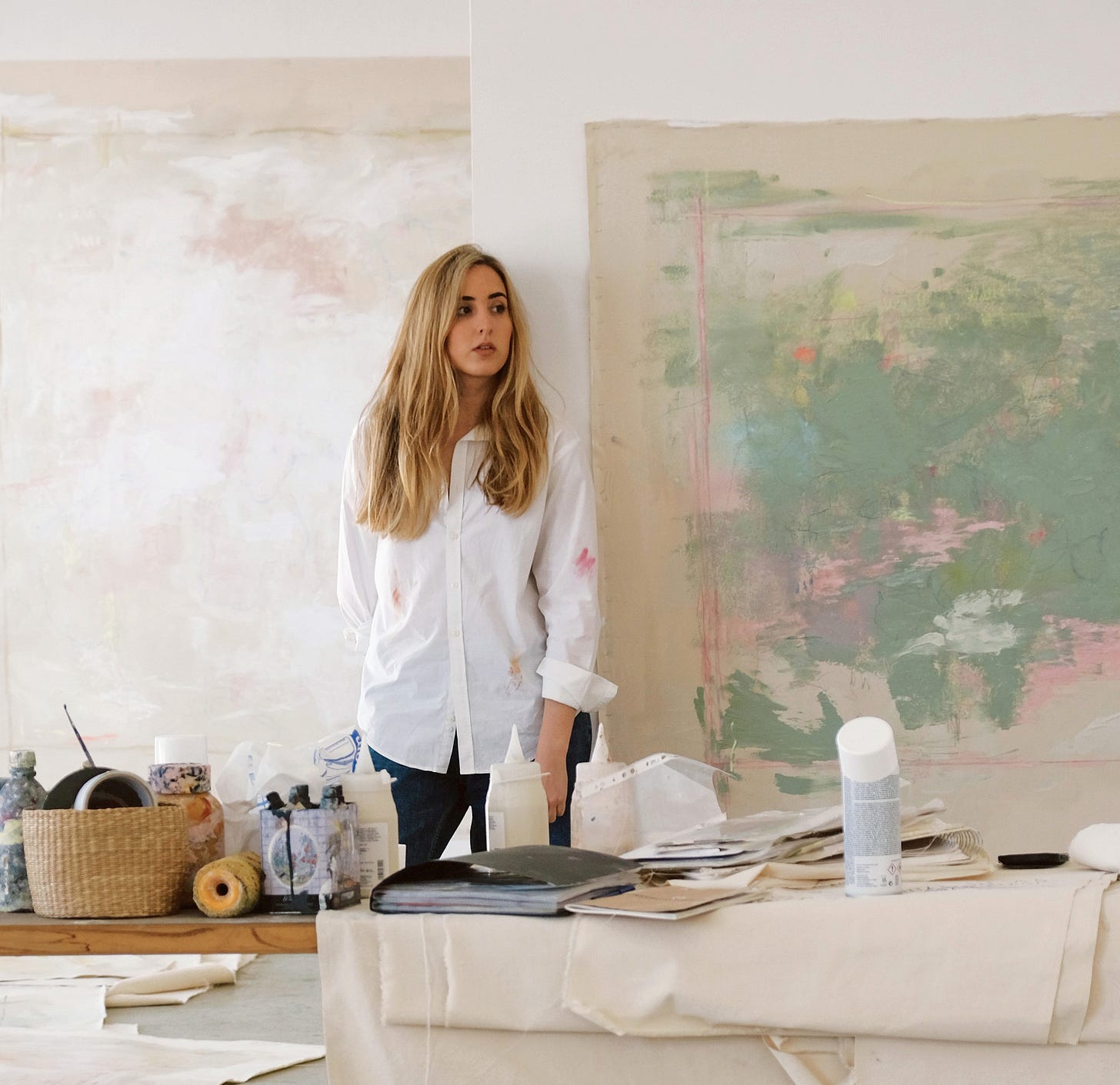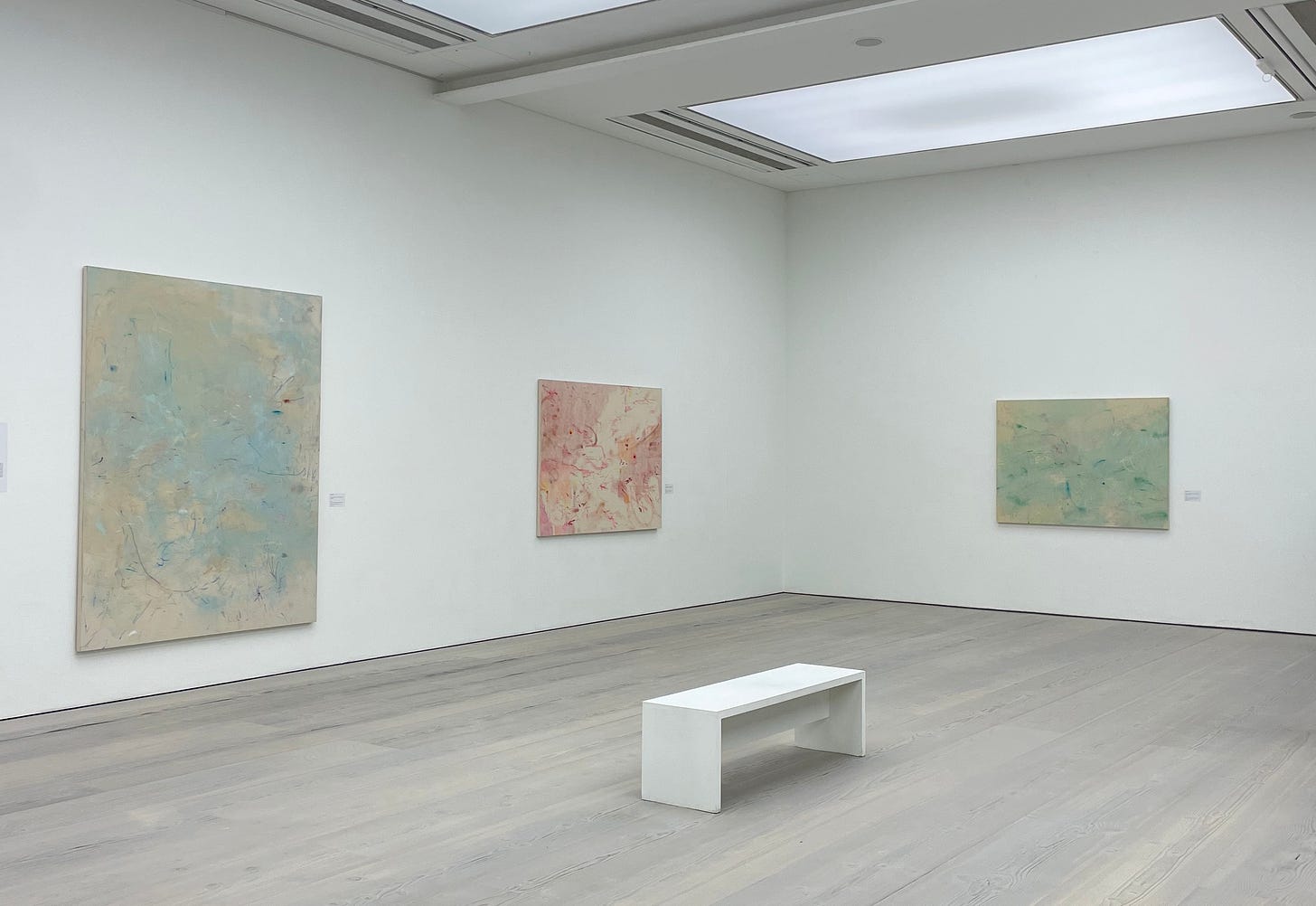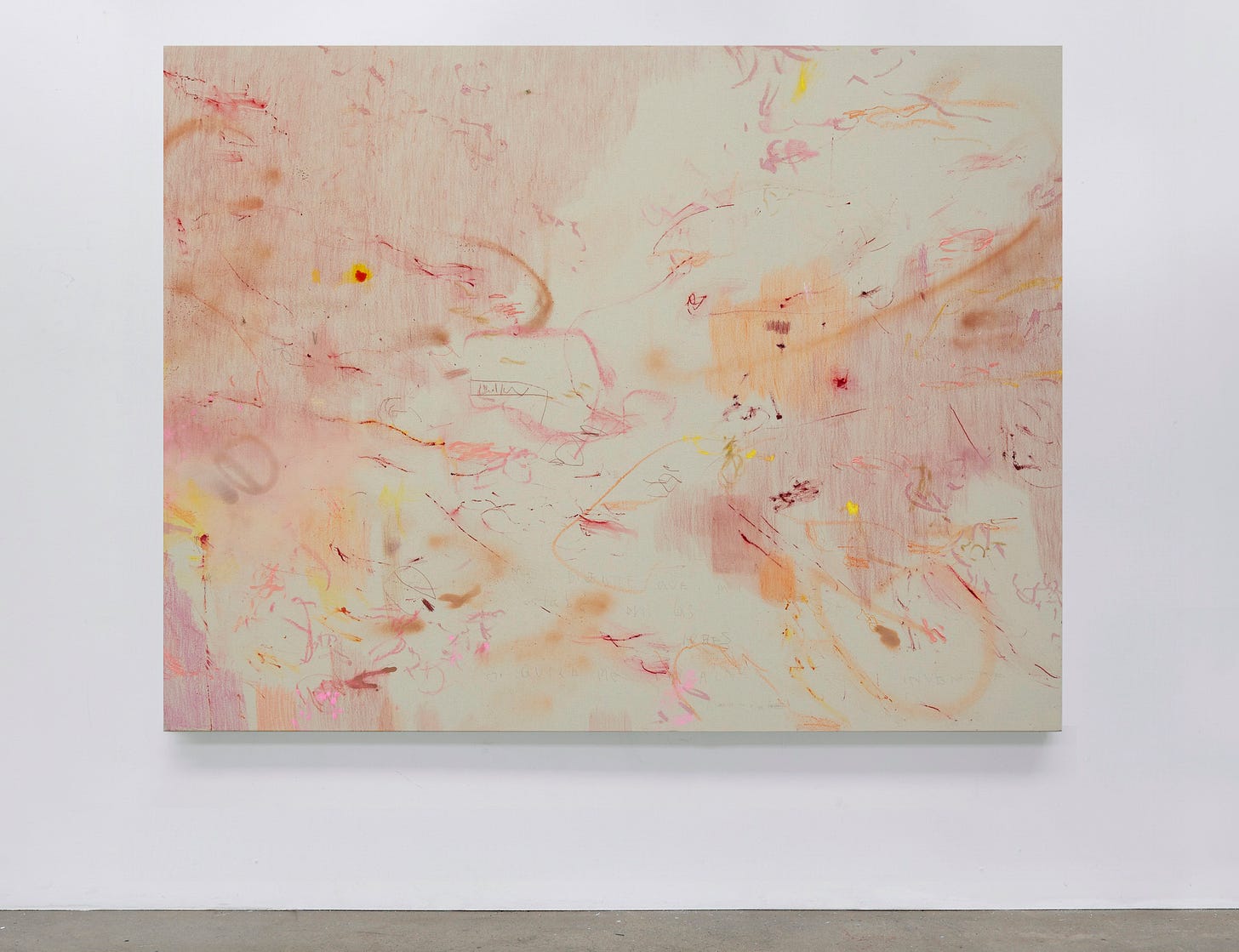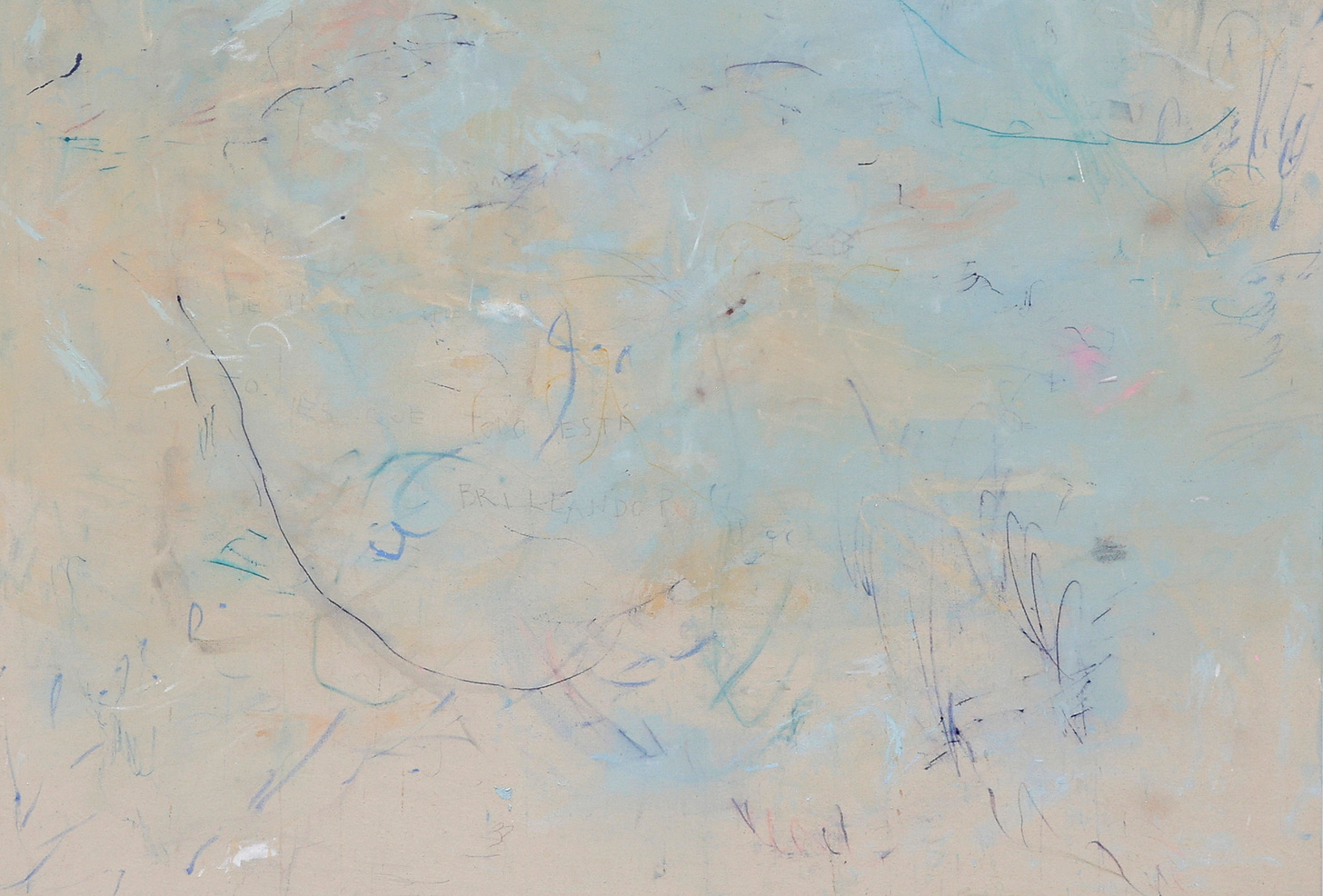The kind of paintings I find myself returning to are the ones that don’t scream What you see is what you get. There’s the surface, always, and then there’s what emerges if you stop and really look. This kind of painting rewards you when you pay closer attention, with delicious details and a slightly heightened perception of surfaces that exist beyond the walls of the gallery.
I think the paintings of Ana Monsó exemplify this kind of secondary viewing experience. On first glance, they appear simple - a wash of colour, a minimalist monochrome perhaps? Then you move closer and notice all the different marks, brushstrokes, poetic text, and tonal shifts. Layers seem to pop in and out of focus, with an ethereal fog that invites you to investigate the secret details hiding in the canvas.
Ana’s paintings contain a kind of quiet chaos that attracts me as both a painter and an art lover. I was also lucky enough to see her work a couple of times in London, where the full scale of her details became apparent to me. I thought we had some things in common as artists so I wanted to hear from the Spanish artist herself. If you get the chance, go experience Ana’s work in real life!
Hey Ana. At your Cascades show, I remember enjoying the hidden text in your painting, something like “todo está brillando”. Where does the text come from?
The hidden text you found in the artwork is, ¿Es la luz de la noche o es que todo está brillando?, which is not only written on the canvas but also the name of the painting. The writing in my paintings comes from my own memories with beloved people or myself. I try to rescue my lived experiences through these narrations of the memories.
Does a piece start with those ideas then?
The way I start the painting is less with an image and more with a question in mind. I tend to imagine fake conversations with myself or a beloved person, from which I attempt to get answers to the questions I’ve never been courageous enough to ask. This concludes with a long-written conversation about a certain memory between me and the real or imaginary person I had the memory of.
Once the internal dialogue, which can last for hours, is concluded, I pick a sentence of that dialogue and write it on a blank canvas. That’s how my painting process starts. In the case of the painting you’re talking about, the first marks on the canvas were the trace of the words ¿Es la luz de la noche o es que todo está brillando? [Is it the light of the night or is everything shining?].
What do you like about hiding little lines of text in your work?
I think the text is less a ‘liking’ and more a necessity. It’s my way of starting the mark-marking. I think that instead of writing the text, I’m drawing the letters. To some extent, it’s my tool to jump from the written memory to the chaotic mark-making that occurs afterwards; and also, a tool to avoid my fear of the blank canvas. In all my artworks there’s writing, but not just the text that is obviously such, but also in all the brushstrokes found in the painting, they’re hieroglyphs from which the code has been lost, a loss that plays into the content of the painting itself.
I also love how ethereal and floaty your works are. Can you tell me more about the experience of making them and then the viewer experiencing them?
When making my paintings I feel like I’m having déjà vu, like having an inaccurate impression of an experience with an undefined or uncertain past. I feel like I’m experiencing something that almost certainly didn’t happen, but that did happen. There’s therefore no separation in my memory - in my perception - between what has happened and what is imagined. My perception is my memory, and my memory is my perception.
My artworks represent the non-drama of the mundane, of the collection of memories that I’ve recorded in my subconscious, hence my gaze is always fixed on the abysmal void, on those spaces that remain to be explored. I try to collect through brushstrokes that are always unfinished and colours that never fully express themselves. That’s why, usually, when looking at my paintings you maybe get a sense of ethereal and floaty, maybe also even the sense of fogginess, of not knowing what is and isn’t there.
Tell me about your colour choices which seem important and intentional. I love the muted colours!
To be completely honest the colours aren’t that much meditated. They burst out naturally and intuitively without me thinking properly about what colours I’m using. It’s something very raw, and hopefully I don’t disappoint too much, I would even dare saying unintentional. Sometimes it can even be hard for me, as my paintings are not pre-planned, and I chose not to draw preparatory sketches first, there’s always the possibility of failure when choosing the colours or forms.
How do you normally work, on the floor, off the stretcher? I was wondering if that was also tied to the way you approach mark-making, as you have so many interesting gestures going on.
I always work on the wall. I staple the paintings on the wall as if they were going to be stretched there forever. I’ve always struggled with the bounciness when painting on a stretched canvas on a stretcher. When you see me painting it looks as if I was fighting against the cotton canvas, as if I had declared war against it. I slap it, I stab it with colour pencils and markers, I punch it with oil pastels - you name it. And so, I need a very sturdy surface behind it.
This also helps me to reconnect with my younger self and my childhood memories. When I was 7 years old, my mum gave me my first big artistic project. She gave me some paints and told me to do a painting on the wall of my room, painting straight on my wall. I painted a huge angel and wrote down with words: I want wings (Quiero Alas). The freedom I felt by being allowed to paint straight on my room’s wall at that young age has clearly influenced me, as for some reason I have an obsession with paint on walls.
I know you studied at the RCA in London but you come from Spain? Whereabouts? And how important is it to retain that Spanish identity in your work, whether it’s in the Spanish text or something else?
I’m from Barcelona, and I’m now working and living in Madrid. I’ve tried the London life, before doing my master’s at the RCA, I had previously lived in London for four years. And so I’ve lived five years total in England. I love the UK, but in the end I realised that no matter how hard I tried, my roots are in Spain: my culture, my language, “my” weather, my family and my friends. I grew a sense of belonging to a place, whilst not being there, that just made me want to reconnect with it even further. Using my own language to write in my artwork, whilst I was in London, was a simple way for me to teleport myself home in Barcelona, which was key when I felt homesick or lonely.
What are your plans going into 2025? Do you have any shows lined up?
I was recently selected as the European winner for the Art for change Prize 2024 at the Saatchi Gallery in London. That has been an incredible opportunity for me. Being able to see my works in such an amazing space left me, on the day of the opening, almost speechless. I’ll also be participating in a group show in Brescia, Italy, with some of my former RCA fellows, opening on the 22nd of February. Other than that, my plans for 2025 are to see what happens next, to let things unfold naturally and to let everything that comes to me in the future be an opportunity. My aim is to let a new group of paintings slowly emerge.
Lastly, any shout-outs?
Yes, my mum, Rosa Galindo (@rosagalindoroura).
I don’t think it’s fair to start talking about my work without talking about my mum first. For a while now I’ve been trying to hide the fact that my mum is a painter herself. For some reason, most likely due to my young age and the fact that I want to have my own voice and be independent from my parents, I’ve been avoiding letting others know the fact that my mum has been an artist since I was born.
However, I can’t talk about me and my artwork without pointing out that she has been my biggest visual artistic influence ever; and there’s always something of her in my paintings. I’m not trying to be her. She just pops out without me noticing.
So, shout-out to my mum!!!
Follow Ana on Instagram: @ana_monso
Things on Our Radar This Week
The controversy around AI trained on copyrighted artists’ work ending up at a big art auction, lots to think about
A lovely tour of the awesome looking Etel Adnan at White Cube New York (wish we could go!!)
The Best Painting Shows in London This Month
Laurence Watchorn Paintings at The Bomb Factory Shoreditch (ends this weekend!)
Philipp Zollinger at Approach Gallery (ends this weekend!)
Martin Daiber at Beers London (ends 1 March)
Jemima Moore’s ‘Slipstream’ at Blue Shop Galleries (ends 23 Feb)
Porous Abstraction at Alma Pearl (ends 22 March)
‘On Paper’ at Galerie Max Hetzler ft. Karel Appel, Tal R & more (ends 22 Feb)
The ‘Slab’ group show feat. Kes Richardson at The Bottle Factory (opens 21 Feb)
Thanks for reading, see you next time!
Oliver & Kezia xx
Palette Talk is free and we hope to grow with your support. If you’ve enjoyed reading, drop us a donation via PayPal…


